

The Walking Man, ca. 1880 (Bronze 86.5 x 59.6 x 26.7cm)
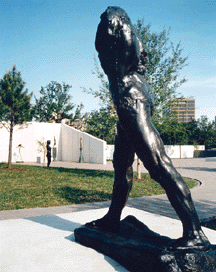
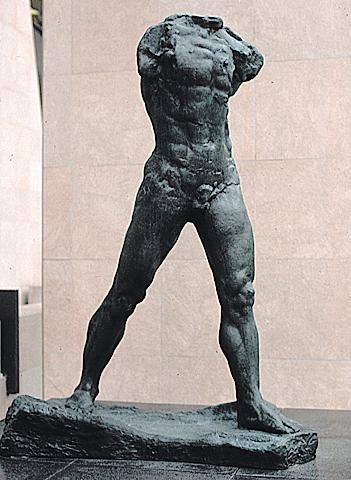

Movement is the transition from one one position to another.


The
Walking Man, ca. 1880 (Bronze 86.5 x 59.6 x 26.7cm)



 Legs
hold a torso away from the earth.
Legs
hold a torso away from the earth.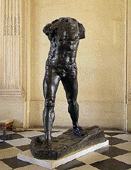
Walking
Man is actually a reworking of Rodin's Saint John the Baptist.
Rodin was inspired to create such a statue upon first sight of his model,
a 42 year-old Abruzzi peasant by the name of Pignatelli, in whom he "saw"
his St. John and described him as "a man of nature, a visionary, a believer,
a forerunner come to announce one greater than himself". Rodin wanted to
create a statue involved in the single, intense moment of expression of
St. John the Baptist (patron saint of Florence) preaching; however, it
would appear that he also wanted to communicate the potential for movement
as well as the emotional quality of the sculpture. Rodin's preliminary
drawings reveal that the figure of St. John originally carried a shepherd's
cross that was later eliminated. Apparently, when Rodin discovered that
it would disturb the harmony, movement, and gesture of the figure, he altered
the drawing. The statue was made in pieces (the torso being the first to
be exhibited in 1890), then assembled (in 1900), and the "model" for each
part of the body and personality of Rodin's statue may also contribute
to the fragmentation of movement and visual harmony:
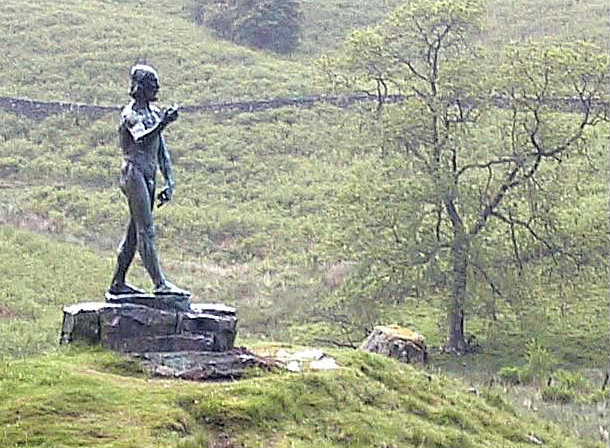
'Take my St. John, for example,' Rodin explained to Paul Gsell, `While he is represented with both feet on the ground, a snapshot of a model executing the same movement would probably show the back foot already raised and moving in the direction of the other one.'
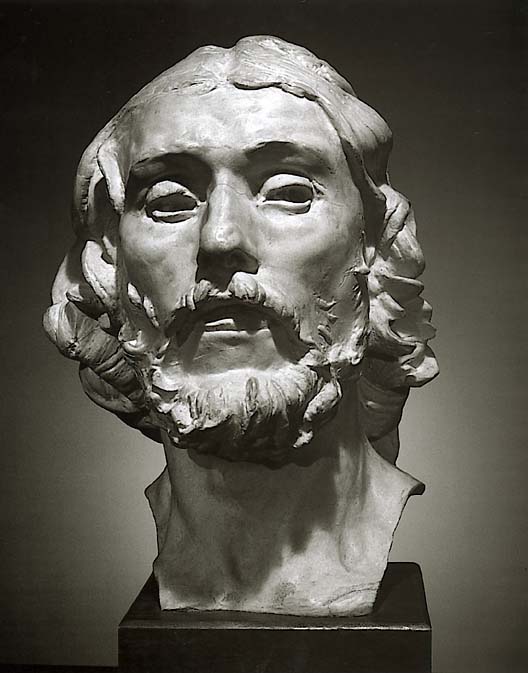
Walking Man was given to the French Embassy in Rome for the
50th anniversary of Italian reunification, but was sent back in 1916 by
Barré (who called it "only a broken statue"), with the excuse that
it impeded traffic! St. John of the Column is another embodiment - St.
John spent more than 30 years, until his death, at the top of a column,
where he received his food by means of a basket attached to a cord.
And even in those of my works in which action is less pronounced,
I have always sought to give some indication of movement. I have very rarely
represented complete repose. I have always endeavored to express inner
feelings by the mobility of muscles.
Rodin

![[marche]](homme-marche.jpg) Walking
Man (Homme qui Marche) 1960 (bronze, 190 x 27 x 110 cm), Kröller-Muller
Museum, Otterlo Louisiana, Copenhagen
Walking
Man (Homme qui Marche) 1960 (bronze, 190 x 27 x 110 cm), Kröller-Muller
Museum, Otterlo Louisiana, Copenhagen
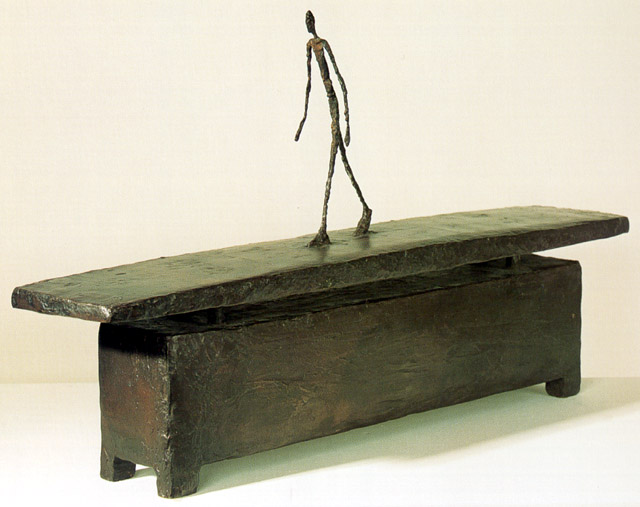 Man Walking in the Rain (Homme qui marche sous la pluie)
Man Walking in the Rain (Homme qui marche sous la pluie)
1948 (bronze, 46.5 x 77 x 15 cm). Alberto Giacometti Foundation, Kunsthaus
Zurich, "Alberto Giacometti 1901-1966", book by Tony Stooss and Patrick
Elliott
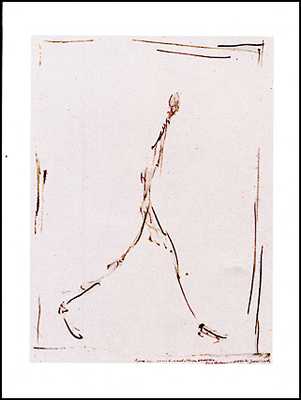 Man Walking (24 x 31 paper)
Man Walking (24 x 31 paper)
 Walking Woman
(Femme qui Marche), 1933 Swiss (Bronze Height: 59 in.) Henry Lee Higginson
and William Frances Warden Funds
Walking Woman
(Femme qui Marche), 1933 Swiss (Bronze Height: 59 in.) Henry Lee Higginson
and William Frances Warden Funds
Most art critics assumed that those thin. gaunt figures were rising from the ashes of Europe after the Holocaust, embodiments of existentialism. Giacometti himself often said they were his homage to the ancient Greek and Egyptian art he saw and sketched at the Louvre Museum and Musée de l'Homme in Paris. But many critics say it is the very ambiguity of the images that give them such power.
In the late 1930s his career was interrupted - first by an accident when a car ran over his foot, then by the outbreak of war. In 1941, in wartime Paris, he made very important new friendships, with the philosopher Jean-Paul Sartre and Simone de Beauvoir. But as the Occupation tightened its grip, he moved to Switzerland, arriving in Geneva on the last day of 1941.
In a famous encounter, the head of the surrealist movement, Andre Breton, asked Giacometti whether any artist cared what a human head looked like. Giacometti said, "I do." Giacometti was tricked into attending what turned out to be a Surrealist tribunal. Before the proceedings could be fully started, he said, 'Don't bother. I'm going,' and turned his back and walked out. There was no public excommunication, but his friends in the movement deserted him.
Establishing yourself, furnishing a house, building up a comfortable
existence, and having that menace hanging over your head all the time -
no, I prefer to live in hotels, cafés, just passing through.
 Unique Forms in
the Continuity of Space
Unique Forms in
the Continuity of Space
The Italian and Russian Futurists such as Russolo, Boccioni, Larionov and Goncharova, attempted to represent movement: an approach known as "dynamism".
Universal dynamism must be rendered as dynamic sensation ... motion
and light destroy the substance of objects.
Futurist manifesto
 the
Italian 20 Eurocent
the
Italian 20 Eurocent
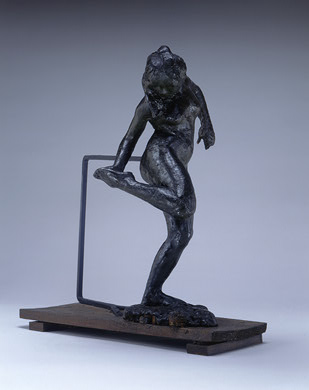 Dancer Looking at
the Sole of Her Right Foot (c.1890/1900), dark green wax and cork, height
without base: 45.7 cm, overall with base: 50.8 x 17.78 x 44.45 cm (National
Gallery, Washington DC)
Dancer Looking at
the Sole of Her Right Foot (c.1890/1900), dark green wax and cork, height
without base: 45.7 cm, overall with base: 50.8 x 17.78 x 44.45 cm (National
Gallery, Washington DC)
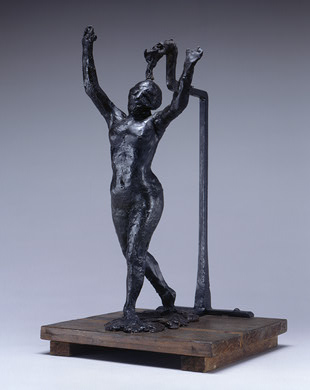 Dancer Moving
Forward, Arms Raised (c.1885/1890), greenish-black wax, metal armature,
height without base: 35 cm (National Gallery of Art, Washington DC)
Dancer Moving
Forward, Arms Raised (c.1885/1890), greenish-black wax, metal armature,
height without base: 35 cm (National Gallery of Art, Washington DC)
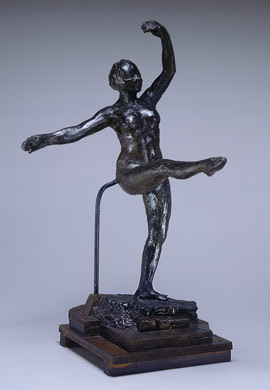 Fourth Position
Front, on the Left Leg (c.1885/1890), yellow brown wax and plastilene,
height without base: 56.83 cm (National Gallery of Art, Washington DC)
Fourth Position
Front, on the Left Leg (c.1885/1890), yellow brown wax and plastilene,
height without base: 56.83 cm (National Gallery of Art, Washington DC)
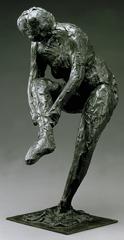 Dancer
Putting on her Stocking, bronze (The Minneapolis Institute of Arts)
Dancer
Putting on her Stocking, bronze (The Minneapolis Institute of Arts)

Young 14 year-old Dancer Bronze statue with diversely coloured patina,
with a tulle ballet skirt, and a satin ribbon in her hair, 0.98 x 0.352
x. 0.245 m, (Paris, Musée d'Orsay and National Gallery of Art, Washington
DC, where it shown being x-rayed by Suzanne Glover Lindsay and Shelley
Sturman)
During his lifetime, Edgar Degas exhibited only one of his wax sculptures (this one) and cast three in plaster. Immediately after his death, 72 of his waxes were cast in bronze editions of 22 to 25 examples each. Given the scarcity of documentary evidence, the original dates of execution for nearly all the waxes are simply not known. The original Little Dancer caused a furor when first exhibited in 1881. Made of tinted wax and dressed in real clothes, the sculpture outraged many viewers' sense of propriety. One critic railed: "Wishing to present us with a statuette of a dancer, he has chosen amongst the most odiously ugly.... Oh, certainly, at the very bottom of the barrel of the dance school, there are some poor girls who look like this monster.... but what good are they in terms of statuary? Put them in a museum of zoology, of anthropology, of physiology, all right: but in a museum of art, really!" This hostility was, however, very much to the point, as Degas was clearly using the sculpture to question accepted ideas of art. Joris-Karl Huysmans, a generally more sympathetic critic observed: "The terrible truthfulness of this statuette is a source of obvious discomfort... all their notions about sculpture, about that cold, inanimate whiteness, those memorable stereotypes replicated for centuries, are demolished. The fact is that, on first blow M. Degas has overturned the conventions of sculpture." With its incorporation of ordinary materials there is a good argument for making Degas' "first blow" the first modern sculpture.
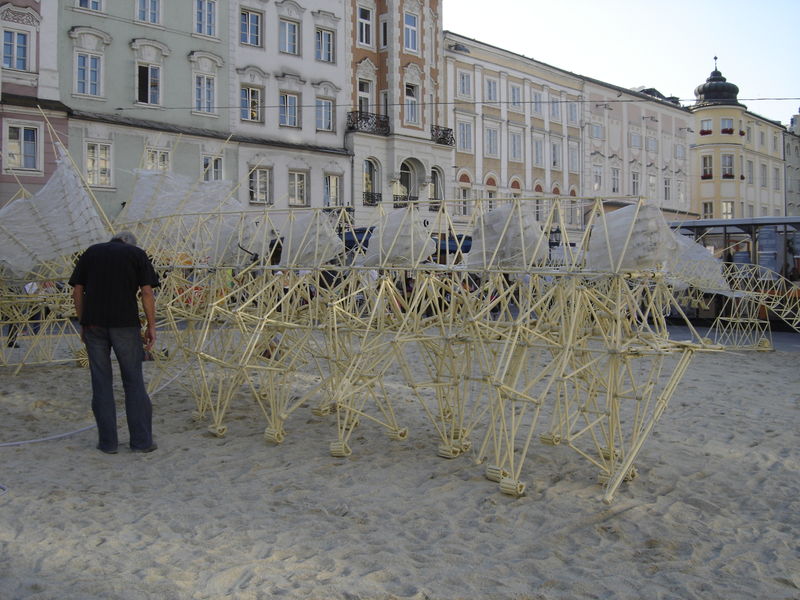
Dutch artist/engineer Theo Jansen makes unbelievable kinetic sculptures; it's as if da Vinci had access to PVC. This video (a BMW ad, as it happens) shows off some of his walking machines in motion on the beach.
Theo Jansen wants to make "life" and he figures the best way to do it is to start from scratch.
 A self-styled
god, Jansen is evolving an entirely new line of animals: immense multi-legged
walking critters designed to roam the Dutch coastline, feeding on gusts
of wind. Over the years, successive generations of his creatures have evolved
into increasingly complex animals that walk by flapping wings in response
to the wind, discerning obstacles in their path through feelers and even
hammering themselves into the sand on sensing an approaching storm.
A self-styled
god, Jansen is evolving an entirely new line of animals: immense multi-legged
walking critters designed to roam the Dutch coastline, feeding on gusts
of wind. Over the years, successive generations of his creatures have evolved
into increasingly complex animals that walk by flapping wings in response
to the wind, discerning obstacles in their path through feelers and even
hammering themselves into the sand on sensing an approaching storm.
A scientist-turned-artist, Jansen's bizarre beach animals have their roots in a computer program that he designed 17 years ago in which virtual four-legged creatures raced against each other to identify survivors fit enough to reproduce. Determined to translate the evolutionary process off-screen, Jansen went to a local shop and found his own alternative to the biological cell -- the humble plastic tube.
 "Animals
are machines as well," said Jansen. "I was making animals with just the
tubes because they were cheap but later on they turned out to be very helpful
in making artificial life because they are very flexible and multifunctional
as well. I see it now as a sort of protein -- in nature, everything is
almost made of protein and you have various uses of protein; you can make
nails, hair, skin and bones. There's a lot of variety in what you can do
with just one material and this is what I try to do as well."
"Animals
are machines as well," said Jansen. "I was making animals with just the
tubes because they were cheap but later on they turned out to be very helpful
in making artificial life because they are very flexible and multifunctional
as well. I see it now as a sort of protein -- in nature, everything is
almost made of protein and you have various uses of protein; you can make
nails, hair, skin and bones. There's a lot of variety in what you can do
with just one material and this is what I try to do as well."
With plastic tubes costing about 10 cents a meter and with cable ties, nylon strings and adhesive tape doing the rest, these lightweight, insect-like beasts are pretty inexpensive to create. Designed to live on the beach and race on wet sand, their evolution hasn't been easy. While Jansen initially used a computer program to figure out the most effective design to get the feet walking, all of his subsequent creations have been entirely free-form, constructed solely through trial and error.
"I've seen a lot of mechanical sculpture, and Jansen's animari are the finest I've seen by far in the 'low-tech clockwork' mechanism category," said Carl Pisaturo, a robotic designer. "By clockwork, I mean mechanisms that have intrinsic, not universally controllable actions, and by low-tech I mean parts more 'crafted' than machined, and the lack of electronic or electrical systems. These are amazing creations and the simplicity of the technology and the fact that they are wind-powered only makes their poetic motions more impressive."
Each animal is made up of 375 replaceable tubes whose respective lengths represent the beast's very own unique "genetic code" influencing its quality and its walking pattern. Many of the initial species failed to stand or died out over time, and later models tackled different problems. The Animaris Arena rolled out a trunk that had a hammer that drove a pin into the ground to prevent itself from being blown away in a storm, and the Animaris Sabulosa tried to push down its nose in the same situation
Jansen is dedicated to creating artificial life through the use of genetic
algorithms. These programs simulate evolution inside their code. Genetic
algorithms can be modified to solve a variety of problems including circuit
design, and in the case of Theo Jansen's creations, complex systems. Some
measure of "fitness" is introduced into the algorithm; in Theo's case it
is to survive on the beach while moving around within two enclosing lines
on the wet sand near the ocean, and the dry sand at the edge of the beach.
Those designs best at the assigned task within the modeled beach environment
are bred together and graded again. Over time complex designs emerge which
sprout wings and flap in the breeze pressurizing what look like plastic
2 liter soda bottles. Articulated legs sprout and scuttle across the sand
like those of a crab. Theo uses plastic electrical conduit to make some
of the computer's most promising designs. He then lets them roam free on
the beach, measures their success, and updates his model.

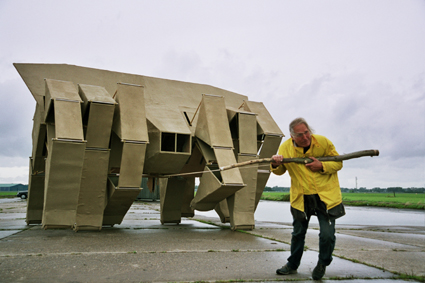 Animaris
Rhinoceros Transport
Animaris
Rhinoceros Transport
Animaris Currens Ventosa walking
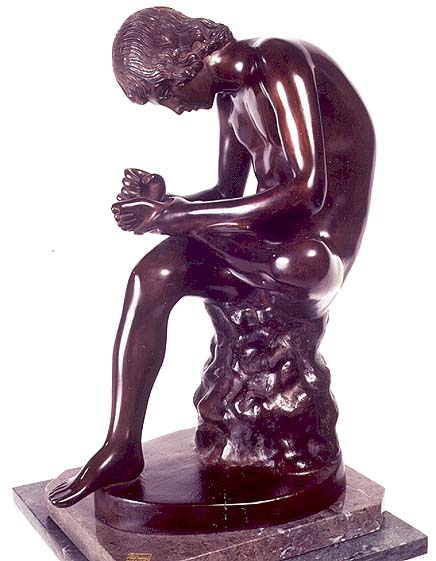
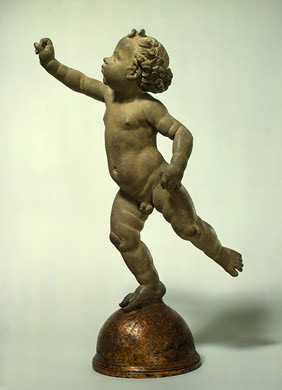
The Florentine sculptor and painter is ranked second only to Donatello among the Italian sculptors of the Renaissance. His bronze of the bandit, Colleoni, was considered the greatest equestrian statue in the world.
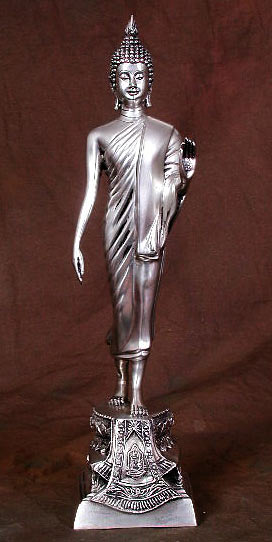 The
walking Buddha is unique to the Sukhothai (1243) style of sculpture. This
asana
(posture) is said to symbolize Buddha's walking down from Tavatisma Heaven
after he had visited his mother. Alternately, it has been interpreted as
Buddha moving foward to offer the world his teachings. Buddha images
are made in one of four asanas - walking, standing, sitting, reclining
- each with a distinctive mudra, or hand position. The posture of
walking was once fairly common during the Sukhothai period in Thailand,
but as later kingdoms emerged, the seated attitude of Calling the Earth
to Witness became more common. The Buddha has a graceful appearance,
as if he was not just walking, but more gliding on air.
The
walking Buddha is unique to the Sukhothai (1243) style of sculpture. This
asana
(posture) is said to symbolize Buddha's walking down from Tavatisma Heaven
after he had visited his mother. Alternately, it has been interpreted as
Buddha moving foward to offer the world his teachings. Buddha images
are made in one of four asanas - walking, standing, sitting, reclining
- each with a distinctive mudra, or hand position. The posture of
walking was once fairly common during the Sukhothai period in Thailand,
but as later kingdoms emerged, the seated attitude of Calling the Earth
to Witness became more common. The Buddha has a graceful appearance,
as if he was not just walking, but more gliding on air.
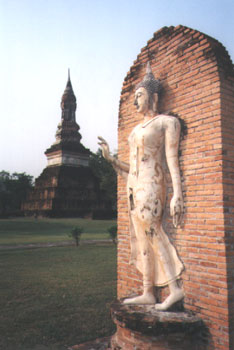
 In
some, the hand is raised in the gesture of Warding off Fear / Protection
from Evil. This hand gestures is known as the Abhya Mudra.. There
is an interesting legend about this hand gesture. Devadatta, a cousin of
the Buddha, had been jealous of the Buddha. As Devadatta's pride increased,
he attempted to murder the Buddha by releasing a rampaging elephant into
the Buddha's path. But as the elephant approached him, Buddha displayed
the Abhaya mudra, which immediately calmed the animal. Accordingly, it
indicates not only the appeasement of the senses, but also the absence
of fear. People who are looking to overcome fear in their own lives, or
overcome jealousy, will therefore often meditate upon an image of the Buddha
in the Abhya mudra. In Chinese and Japanese art this hand gesture can be
a symbol for teaching of the Dharma.
In
some, the hand is raised in the gesture of Warding off Fear / Protection
from Evil. This hand gestures is known as the Abhya Mudra.. There
is an interesting legend about this hand gesture. Devadatta, a cousin of
the Buddha, had been jealous of the Buddha. As Devadatta's pride increased,
he attempted to murder the Buddha by releasing a rampaging elephant into
the Buddha's path. But as the elephant approached him, Buddha displayed
the Abhaya mudra, which immediately calmed the animal. Accordingly, it
indicates not only the appeasement of the senses, but also the absence
of fear. People who are looking to overcome fear in their own lives, or
overcome jealousy, will therefore often meditate upon an image of the Buddha
in the Abhya mudra. In Chinese and Japanese art this hand gesture can be
a symbol for teaching of the Dharma.
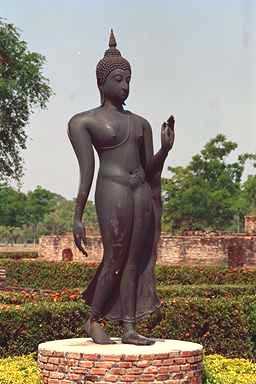
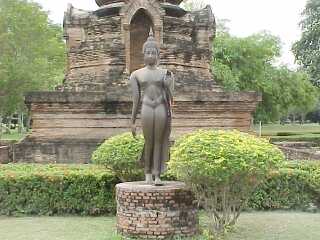
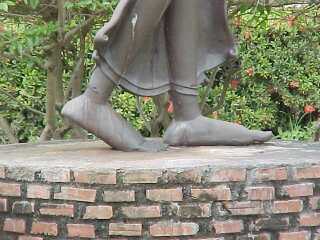
Wat Sa Si outside Wat Mahathat, Historic Park of Sukhothai
Roosevelt contracted polio in August 1921 while on a family vacation
at Campobello Island in New Brunswick, Canada.
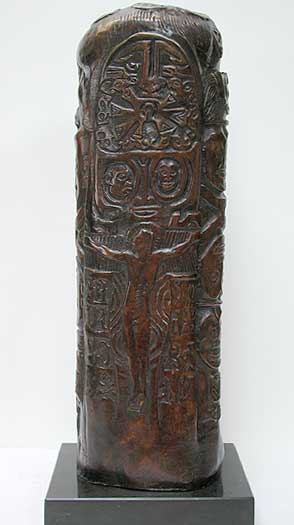 Eugène
Henri Paul Gauguin was born in Paris on 7 June, 1848, the son of Clovis
Gauguin, a Republican editor, and his wife Aline Marie Chazal. In 1849,
after Louis Napoléon came to power, the family emigrated to Peru.
Clovis Gauguin died on the way. His widow and 2 children (Paul and his
elder sister Mari) stayed in Lima with their rich relatives and did not
return to France until 1855. At age 17, he became a sailor in the French
merchant navy, and first learned about the South seas. After the death
of his mother in 1867, he settled down with his wealthy guardian, Gustave
Arosa, who had a large art collection that included works by Delacroix.
This period in time shaped Gauguin's interest in the arts. He started collecting
Impressionist paintings, and became an amateur painter. This lasted until
he was 23. At this time Gauguin became very successful: he was a wealthy
stockbroker, married Mette-Sophie Gad, from Denmark, and had five children.
At 34, the stock market crashed and he lost his job. The result was poverty.
Soon after, the family decided to move to Mette's homeland, Denmark. In
1885 Gauguin came back to Paris - alone. Fifteen years after his
separation, he went to Tahiti and discovered primitive art. He enjoyed
it and the surroundings of the South Pacific because it meant he could
paint people and scenery simply and naturally, with vibrant, contrasting
colors. In 1887, Gauguin left France for Panama. For a short time he worked
as a labourer for the Panama Canal Company. He soon left Panama for Martinique,
where he continued his development as an artist. In 1888 he returned to
Brittany. His experience in Martinique broadened his vision and enabled
him to develop original interpretations of scenes in Brittany. In October,
1888 he travelled to Vincent van Gogh's home in Arles, France. His stay
was both traumatic and fruitfull for both artists. They learned a great
deal from each other but were often at odds. Gauguin returned to Paris
in December after Van Gogh's "ear incident."This proved to be a turbulent
arrangement. Thus Gauguin moved again, to Brittany, where he painted the
walls and ceiling of an inn, and sculpted in wood and marble.
Eugène
Henri Paul Gauguin was born in Paris on 7 June, 1848, the son of Clovis
Gauguin, a Republican editor, and his wife Aline Marie Chazal. In 1849,
after Louis Napoléon came to power, the family emigrated to Peru.
Clovis Gauguin died on the way. His widow and 2 children (Paul and his
elder sister Mari) stayed in Lima with their rich relatives and did not
return to France until 1855. At age 17, he became a sailor in the French
merchant navy, and first learned about the South seas. After the death
of his mother in 1867, he settled down with his wealthy guardian, Gustave
Arosa, who had a large art collection that included works by Delacroix.
This period in time shaped Gauguin's interest in the arts. He started collecting
Impressionist paintings, and became an amateur painter. This lasted until
he was 23. At this time Gauguin became very successful: he was a wealthy
stockbroker, married Mette-Sophie Gad, from Denmark, and had five children.
At 34, the stock market crashed and he lost his job. The result was poverty.
Soon after, the family decided to move to Mette's homeland, Denmark. In
1885 Gauguin came back to Paris - alone. Fifteen years after his
separation, he went to Tahiti and discovered primitive art. He enjoyed
it and the surroundings of the South Pacific because it meant he could
paint people and scenery simply and naturally, with vibrant, contrasting
colors. In 1887, Gauguin left France for Panama. For a short time he worked
as a labourer for the Panama Canal Company. He soon left Panama for Martinique,
where he continued his development as an artist. In 1888 he returned to
Brittany. His experience in Martinique broadened his vision and enabled
him to develop original interpretations of scenes in Brittany. In October,
1888 he travelled to Vincent van Gogh's home in Arles, France. His stay
was both traumatic and fruitfull for both artists. They learned a great
deal from each other but were often at odds. Gauguin returned to Paris
in December after Van Gogh's "ear incident."This proved to be a turbulent
arrangement. Thus Gauguin moved again, to Brittany, where he painted the
walls and ceiling of an inn, and sculpted in wood and marble.
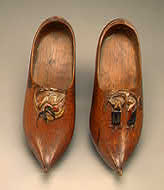 Pair of Wooden Shoes (Sabots), 1889/1890, polychromed oak, leather, and
iron nails, 12.8 x 32.7 x 11.2 cm (NGA, Wash. DC)
Pair of Wooden Shoes (Sabots), 1889/1890, polychromed oak, leather, and
iron nails, 12.8 x 32.7 x 11.2 cm (NGA, Wash. DC)
I love Brittany: there I find the wild and the primitive. When my wooden shoes ring on this stony soil, I hear the muffled, dull, and mighty tone I am looking for in my painting.
In 1895, Gauguin went back to Tahiti. 27 months later, he returned to France. Gauguin did not find any refuge in France, though. First, he broke his ankle in a fight about a mulatto girl with whom he was living.
In passing through Gestel the other day with a comrade, sitting on a bench
near the church we found two remarkable figures, a young man raggédly
clothed, with a strange reckless face, and an old man bent over and leaning
on a heavy stick.
The latter was largely built, his legs half naked, and of a dark metalic,
salmon
colour; and his feet thrust into the straw of his enormous sabots, one
ankle
swollen and wounded, — it was this infirmity that prevented him from working
— he sat motionless beside his insouciant and listless companion. With
a
heavy grey mat of hair, he was dark-skin'd and look'd like some bedouin;
the
flesh was pucker'd round his eyes into innumerable deep wrinkles, as
though some torrid sun were constantly in his eyes: and gazing into Space,
he seem'd to find in the nothingness always before him and blank of his
reverie, the same occupation as those old sailors find, sitting for hours
on
the benches of the quays, and gazing at the empty sea. He look'd at us
steadily when we spoke to him, and answer'd our questions slowly. My
companion ask'd him if he would be painted; he made no difficulty. When
ask'd where was his home, where he was habitually to be found, he replied
simply, with that deep and tragic voice — that had this accent naturally,
as a
voice heard in a ruin'd and deserted dwelling, because of the solitude
and
bareness of his life, — "On the stones" ("sur les pierres",): it was there
that
he sat the greater part of the day, on the cobbles, to receive alms.
Percy Wyndham Lewis
Then an auction sale of his works failed in 1895, and he decided to go back to Tahiti, and then to Hiva Oa in the Marquesas. This period was captured in his book of memoires, Noa Noa.
Gauguin suffered a chronic sore on his left ankle, which had refused to heal for more than two years. This was during his self imposed exile in Tahiti, and he thought the poor healing was due to the tropical climate. In his last years Gauguin's mobility was severely restricted, and he endured considerable pain, on account of his ankle. He became blind and unable to walk. It was later discovered that it was a complication of his syphilis, which eventually led to his death in 1903 on Hiva Oa Island in the Marquesas. In March of 1903 he was fined and imprisoned, and two months later was found dead. Gauguin's native neighbor Tioka, called to see him, announcing his arrival by shouting 'Koke, Koke" from the bottom of the staircase. To his surprise he received no answer. After a short hesitation he climbed the stairs and discovered Gauguin lying an his bed with one leg hanging over the side. Not sure that his friend was really dead, Tioka resorted to a traditional method and bit his head. Gauguin remained silent and motionless. In a shrill voice Tioka intoned an ancient Marquesan death lament.When filling in the death certificate, the priest added, "He was married and a father, but the name of his wife is unknown."
His work, which was influenced greatly by the native symbolism of Tahiti, included a wood carving of Christ on the Cross (Stela of Christ). The left foot of Christ is given greater prominence than any other part of the carving, thus referring to the source of Gauguin's physical suffering, his infected ankle. This piece therefore, has autobiographical significance.
Do not paint too much after nature. Art is an abstraction; derive
this abstraction from nature while dreaming before it, and think more of
the creation which will result than of nature.
- letter to Emile Shuffenecker, 1888
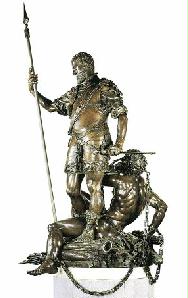
This bronze is one of the most beautiful pieces of Renaissance Statuary.
The two figures rise up over a plinth, around the circumference of which
is the inscription "Caesaris virtute domitus furor" (Rage dominated by
Caesar's valour). On the same plynth, to the left, there is another inscripition
referring to the piece`s creators. In Latin it reads "Leone, the father,
and Pompeo, the son, natives of Arezzo, made this 1564". It is probable
that it was actually Leone who made it and that his son only helped in
its firing. Celebrated in this sculptural group is a victory of the imperial
troops; some argue that it refers to the conquest of Tunis, others that
it is the Battle of Mühlberg against the Protestants. In the figure
of the emperor the clothing is removable, revealing a nude worked in the
fashion of the old deified Roman emperors. In his right hand he carries
a lance that has felled the body of his vanquished foe, while in his left
he has a sword, the hilt of which is shaped like an eagle's head.
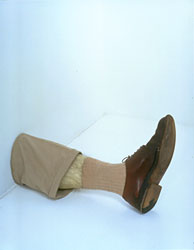 Untitled, 1990.
Untitled, 1990.